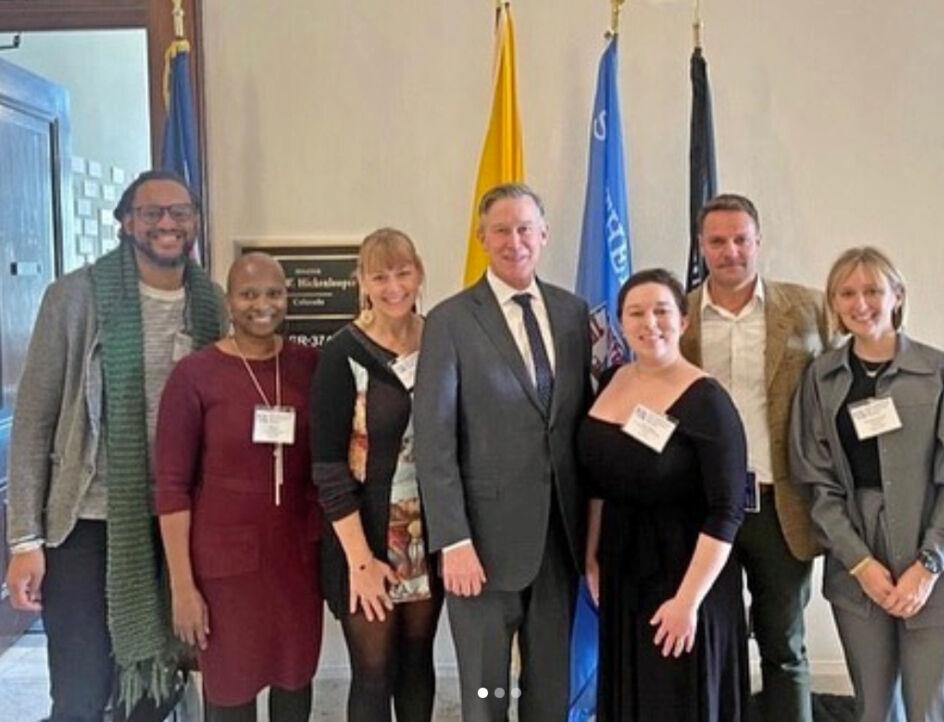There was a familiar hum around the WFUV studios in late October, one that had been slowly coming back in recent months, after COVID-19 forced hosts, programmers, and engineers to figure out a way to work from home for more than a year, leaving the station mostly empty.
In the newsroom, Maya Sargent, a graduate fellow from Fordham’s public media program, sat at a computer editing What’s What, the station’s daily news podcast on current events, cultural news, and issues affecting the New York City area. Down a few seats, Sam Davis, a Fordham College at Rose Hill senior, chatted with Bobby Ciafardini, the station’s sports director, about the guests they’d feature on One on One, the city’s longest-running sports call-in show. A few hours earlier, Jim O’Hara, FCRH ’99, associate director of technical operations, met with several students who would document the next day’s recording session with beabadoobee, a Filipina British artist, in the station’s intimate Studio A setting.
Elsewhere, Rich McLaughlin, FCRH ’01, GABELLI ’10, the station’s program director, met with General Manager Chuck Singleton to review the rundown for the station’s On the Record event, which would take place the following week. And music director Russ Borris was finalizing details for the station’s annual Holiday Cheer concert—a lineup headlined by venerable indie rockers Spoon and featuring Lucius, Grammy-winning blues prodigy Christone “Kingfish” Ingram, and the Brooklyn-based band Say She She.
But afternoon drive host Dennis Elsas tuned all of that out when he stepped up to the microphone in Studio 1. “That is Beck and ‘Loser’ from 1994. And new before that: Arctic Monkeys, ‘I Ain’t Quite Where I Think I Am’—here at WFUV,” Elsas said, then quipped “I’m here!” with comic timing and a smile that traveled hundreds of miles across the airwaves. He cued up the next song, and as he hit play, said, “Member-supported and supporting each other, it’s WFUV.”
It’s the kind of scene that has played out, almost hidden from sight, in Keating Hall on Fordham’s Rose Hill campus for more than 75 years. Before Dennis Elsas, there was Pete Fornatale, FCRH ’67, who created the station’s first pop music show as an undergrad in 1964. Before Sam Davis, there was Malcolm Moran, FCRH ’75, who launched One on One as a student and went on to become a Hall of Fame basketball journalist; and there was Vin Scully, FCRH ’49, the late, legendary baseball broadcaster who was among WFUV’s original voices. Before Maya Sargent, there was Alice Gainer, FCRH ’04, the Emmy Award–winning anchor and reporter at WCBS-TV, New York; and Charles Osgood, FCRH ’54, former longtime host of CBS Sunday Morning.
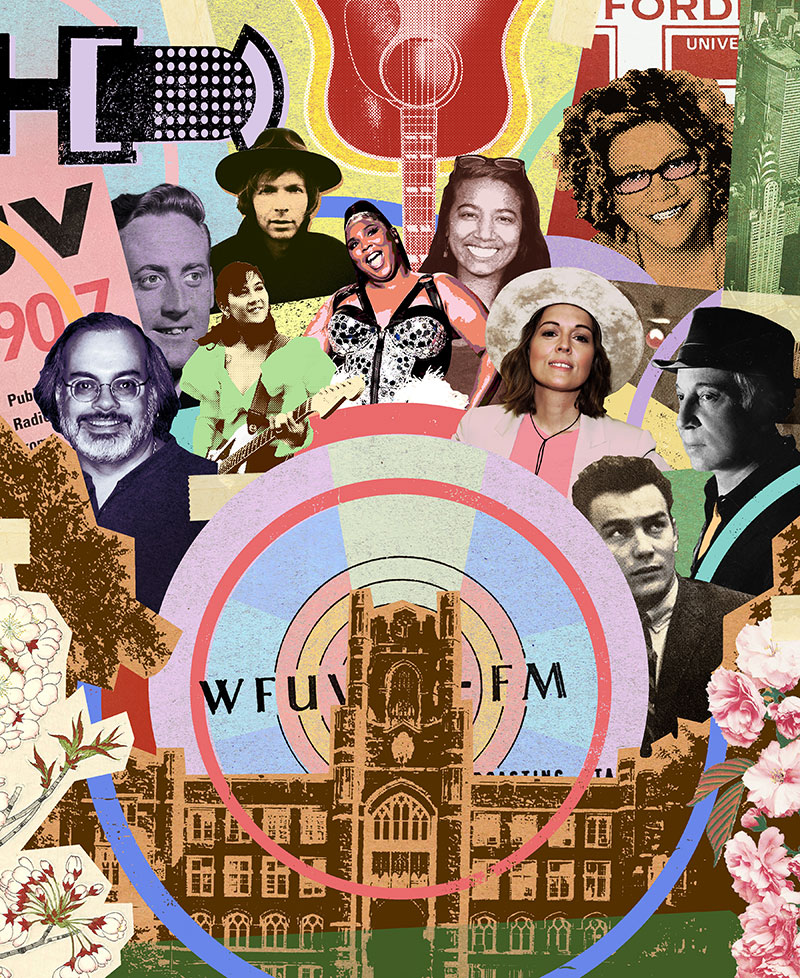
Clockwise from left: Longtime DJ Darren DeVivo, GABELLI ’87; legendary sports broadcaster Vin Scully, FCRH ’49; Michelle Zauner, lead singer of Japanese Breakfast; Beck; Lizzo; midday host Alisa Ali, PCS ’14; Brandi Carlile; Rita Houston, the late, longtime WFUV tastemaker; Paul Simon; and Pete Fornatale, FCRH ’67, the late DJ whose mid-’60s show, Campus Caravan, brought rock music to WFUV. (Collage by Tim Robinson)
A Unique Beginning
“1947 was quite a year,” Fordham Provost Dennis Jacobs, Ph.D., told the crowd of more than 200 attendees at WFUV’s On the Record event, held November 2 on Fordham’s Lincoln Center campus. “Jackie Robinson joined the Dodgers, Chuck Yeager broke the sound barrier, and the transistor was invented. And at Rose Hill, New York’s first noncommercial, educational FM station signed on the airwaves. The University’s 25th president, Robert Gannon, S.J., remarked that ‘Fordham in her time has seen many beginnings. Today, we mark a beginning that is unique.’”
In mid-October, the University’s recently installed 33rd president, Tania Tetlow—who had her own unique beginning at Fordham as the first woman and first layperson to lead the institution—stood onstage in front of Walsh Family Library. “We’re here to celebrate 75 years of WFUV, the coolest thing about Fordham University,” she said during a station-organized concert that was part of the inauguration festivities. The station still trains “students who are learning journalism and sports broadcasting and everything about the industry,” and now, in addition to serving the city, it reaches “300,000 listeners in all 50 states—Idaho and Hawaii listen to WFUV—and we’re just so proud of what it is.”
Throughout its 75-year history, many things have changed. For starters, in the mid-1980s, the station became a professionally run NPR affiliate, with ample training and broadcast opportunities for students. Darren DeVivo, GABELLI ’87, now the station’s Saturday afternoon and weeknight host, was working at the station as a Fordham undergraduate at that time.
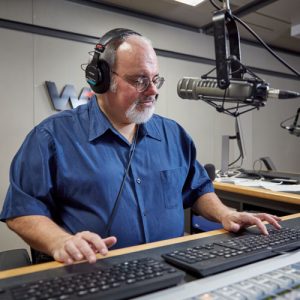
Darren DeVivo, GABELLI ’87, the station’s Saturday afternoon and weeknight host
“When I got here, there was a general manager who was a paid Fordham employee. We had a chief engineer who was a paid employee from Fordham, and everyone else was students—program director, news director, music director, all student-run,” he said. “If you had some skills or had some abilities, you worked your way up.”
In 1985, Ralph Jennings, Ph.D., was hired as the station’s general manager. He brought a fresh vision to the station, working to create an authentic sound, filled with more consistent, impactful programming that would attract an audience and help the station receive financial assistance to support its growth.
“You’re bringing change to what had been a college station—there’s a mix of responses to that,” said Singleton, who started as the station’s first professional news director in 1987 and later served as program director before succeeding Jennings as general manager in 2011. “I think for a lot of alums and students at the time, there was a fear that the students would just be swept out.
But Singleton, who expanded WFUV’s coverage of community issues and helped develop its robust news journalism training program, said that WFUV strived to employ a different model. “It’s not the pure student station, it’s not the pure professional public station: It’s a professional, public station with a lot of public service impact, but one where students are a core part of this. And those opportunities [for students] are really core to the station’s mission.”
In the late 1980s, there was also a shift overall in the field of radio, according to Singleton. “You couldn’t offer a little bit of this and a little bit of that—it wouldn’t get you anywhere,” he said. “So there was new understanding that for a public radio station to attract a loyal audience, you had to be consistent in what you were offering.” Jennings and his team studied the market and found “holes that we could fill,” Singleton said, and at the time, that was primarily singer-songwriters in an “acoustic vein.”
“That format—by the early ’90s—I think it was the first sparks of what it is that we have today,” Singleton said. He noted that these efforts, in addition to technological advances like internet streaming, have paid off and allowed the station to expand its reach: WFUV went from having around 30,000 to 50,000 listeners a week in the 1980s to around 325,000 a week today. At times, the station has reached as many as 450,000 listeners.
Today, staff and students at WFUV are using new platforms like TikTok and podcasts to reach audiences beyond the radio dial. The station’s studios have even moved—from the third floor of Keating Hall to bigger, state-of-the-art studios on the lower level of the Rose Hill campus’ signature academic building. But despite all of its iterations and evolutions, WFUV’s mission and goals have remained consistent—to be a home of music discovery in New York; to be a training ground for the next generation of journalists, broadcasters, and behind-the-scenes wizards; and to provide the community with significant public service.
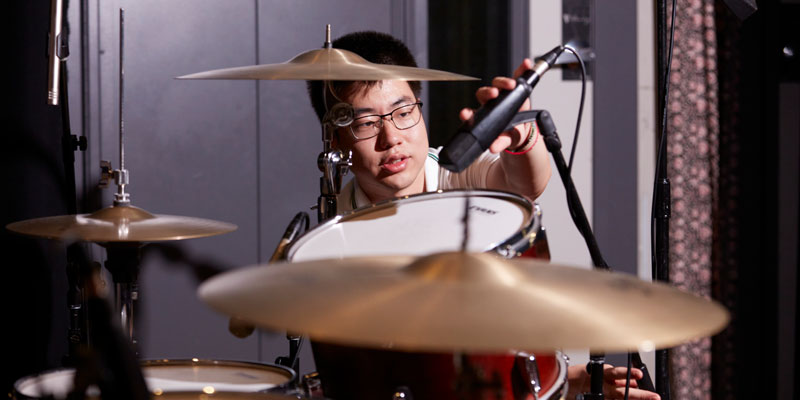
Allen Wang, a Gabelli School junior who is an audio engineer for WFUV, adjusts a microphone in Studio A.
Home of Music Discovery
Throughout its history, WFUV has played a variety of music—from opera and jazz in its early decades to rock in the ’60s and ’70s. But it really found its place more than a quarter century ago, as commercial radio stations began making their playlists “tighter and tighter,” according to Singleton. That left less space for DJs “who had done great creative work”—FM rock pioneers like Dennis Elsas, Vin Scelsa, Pete Fornatale, and Meg Griffin, he said. Elsas, whose legendary career has included a famous two-hour in-depth interview with John Lennon of the Beatles, said that shift came for him after working in commercial radio for more than 25 years. More and more “shock jocks” were coming in and classic rock DJs like himself were being phased out. When he heard about an opening at WFUV in 2000, he jumped at the chance.
“I felt at times challenged because while I was playing a lot of music that I was very familiar with, I was also learning on the job because we were digging way deeper into blues and some more esoteric music,” he said, adding that this allowed him to “expand my musical horizons even further.”
Elsas said that he believes the station’s tagline—Music Discovery Starts Here—fits its work in more ways than one. “You could discover new music, which you couldn’t necessarily find on any other station on the market, and I think it also gave us the opportunity to say you could rediscover old favorites,” he said, adding that he’s had his own discoveries at WFUV, including the pleasure of working with and mentoring students.
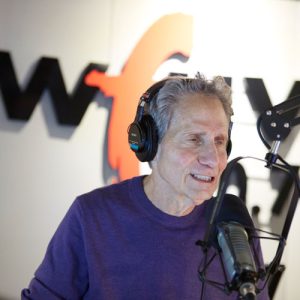
Legendary DJ Dennis Elsas hosts the afternoon drive for WFUV.
DeVivo said that he personally has enjoyed finding new music and sharing it with his audience. “A band like the Jayhawks is a good example, [or] singer–songwriter Freedy Johnston—I remember the day that the album came in, and I put it in and go, ‘Holy smokes! Why don’t we hear this on whatever commercial rock station, because these guys are great,’” he said.
WFUV’s national reputation as a home for music discovery can be traced to Rita Houston, who delighted in introducing listeners to artists from a wide range of genres—folk, blues, indie rock, hip-hop, electronica, and more—and who came to be regarded not only as a tastemaker in the industry but also a trusted mentor and friend to the stars.
For more than 25 years at the station, in her roles as a DJ, music director, and program director—and with her unerring ear for talent—Houston helped elevate the careers of countless artists, including Norah Jones, Brandi Carlile, and Mumford and Sons. When Houston died of ovarian cancer in 2020 at age 59, Carlile recalled how Houston was “the very first person to play my music on the radio.” She also helped Carlile feel accepted and welcome as a fellow LGBTQ woman. Carlile recalled a time when she was showing Houston photos, and a picture of her girlfriend popped up on her phone.
“‘Is that your plus one?’” Houston asked. “‘It’s OK to talk about it.’ She could immediately tell that I was uneasy with people in the music business knowing I was gay,” said Carlile, who was 22 years old at the time.
But Houston, who joined WFUV in the mid-1990s, didn’t stop at artists. She also helped launch the careers of WFUV employees, including McLaughlin, who succeeded her as program director, and Alisa Ali, PCS’14, the station’s midday host, who has helped carry forward Houston’s passion for supporting artists, particularly local musicians.
Houston is the reason Ali came to WFUV—and Fordham—in the first place. She was listening to WFUV, thinking about how she’d love to work there, when she heard Houston say that she was going to give a talk at the Museum of Television & Radio.
“And like any naive person, I was like, ‘I’ll just go see Rita and ask her if I could get a job there and she’ll give it to me,’” she said. So Ali went to Houston’s talk and waited around to chat with her after. “And I’m like, ‘Hi, I love the station. Can I work here?’” she said, smiling at the memory. “She’s like, ‘That’s cute. No, of course you can’t. You have no experience.’”
Ali said that Houston paused and asked her if she was a Fordham student, which was “the only way you could work at FUV” without having any experience in radio.
“I went home and looked up ‘how do you enroll in Fordham University?’” she said. “I was kind of at a crossroads in my life because I didn’t really like what I was doing. And since I never graduated college, I was like, ‘Well if I don’t get a job at WFUV, at least I’ll have a college education.’
“The day after I was accepted, I came back to the station. I was like, ‘Hi, remember me from the talk? I go to school here now. May I have a job now?’” Ali said. “[Houston] was like, ‘All right, kid. I like you. You remind me a lot of myself.’”
At that point, Houston was the midday host and music director, and Ali became a production assistant. She worked her way up to morning show producer and then host of The Alternate Side, which allowed her to discover and play new artists. More recently, as the midday host, she created a segment called “NY Slice,” which features local musicians from the tristate area.
“In New York City, we have so many opportunities to see huge bands, and I think a lot of these little bands get overshadowed,” she said, describing how she came up with the idea for the segment. “Local bands actually have it easier outside of New York City—it’s a disadvantage to be a local, small band in New York City. So I just want to support these people.”
That support has helped artists including Rén with the Mane and Blonde Otter. The two bands were featured on “NY Slice” and later chosen to perform at the October concert following the inauguration of Tania Tetlow. “I love you, Alisa Ali!” Rénee Orshan, the artist behind Rén with the Mane, said from the stage that night, adding that Ali and WFUV are the “only radio station” to play their music.
The concert also featured New Orleans’ legendary Preservation Hall Jazz Band, which has been celebrating its 60th anniversary with a national tour. The group marched down Old Elm Road with the horn section playing the gospel classic “I’ll Fly Away.” As they reached the stage, Tetlow, who grew up in New Orleans, added her own soaring voice to the mix to the delight of the crowd. She later said she was grateful to WFUV and to all the performers for helping her “feel at home here at Fordham.”
Greater Connection to the Artists
The inauguration concert was a prime example of WFUV tying its penchant for music discovery to its commitment to live music. O’Hara estimated that in a typical year, the station hosts about 200 sessions in Studio A and 20 to 30 live concerts and performances at venues throughout the New York City area.

Jim O’Hara, FCRH ’99, associate director of technical operations for WFUV, tests the soundboard for Studio A.
“Live music really gives you a good insight [into]who the artist is,” O’Hara said. “You really get to understand a lot about them by hearing them perform their songs live,” and then listening to a WFUV host interview them in the studio. “It really presents a greater connection to the artists. I think that’s a great thing that we provide to our listeners.”
One of his most memorable sessions came in 2017, when Gorillaz, the Damon Albarn–led British band that doesn’t do a lot of live appearances, reached out to bring their “huge, full-scale tour” to Fordham’s Rose Hill campus. “When we first took the phone call about this, I was like, ‘Well, there’s no way this is going to happen,’” he said, laughing. “Along the way, I was expecting any one of a number of issues to be the deal breaker.” But those issues, ranging from bringing semi-tractor trailers onto campus to hooking up the band’s equipment to the building’s main power source, didn’t stand in their way. The session was a go.
“It was literally an all-day process—we got here, I think it was 7 a.m., and we didn’t leave until like 8 or 9 p.m.,” O’Hara said. “They took over the entire station. They brought the entire tour, what they would bring into Madison Square Garden. And I had just an assembly line of students, working the elevator out there, bringing stuff in, bringing cases back out. I think there had to be 30 members of their team. Every studio was filled up with something.”
But O’Hara said the takeover was absolutely worth it. “It was unique content—we were the one station that got to do that, so it was affirming as to who we are in the industry that we were offered that and were able to accomplish it,” he said. “It was just a really great source of pride for me.”
While Fordham students Allen Wang and Caitria Demeroto weren’t at WFUV for the Gorillaz performance, they’ve gotten their share of hands-on opportunities. The studio sessions typically range from two to four hours and include up to 10 students working on the production—three to four audio engineers, four to five videographers, and usually a few trainees—while the live performances at city venues also call for a mix of students and external contractors.
“There was a show for Phoebe Bridgers at Forest Hills Stadium, which is actually in the neighborhood I grew up in,” said Wang, a junior in the Gabelli School of Business. “So to go and be part of the backstage team, it was a very fulfilling experience. It was also really insightful to see how larger productions work in terms of production teams and sub crews and what their day is like.”
Demeroto, a Fordham College at Rose Hill junior, said she really enjoys the personal, intimate setting of Studio A, where she shot video of the session featuring Gang of Youths, an Australian alternative rock group.
“I think it’s just really authentic—and you feel very close,” she said. “And it definitely is a different sound than a recording. It’s so cool to see them, without any editing yet, and how they interact in their creative process—actually capturing that on camera is really great.”
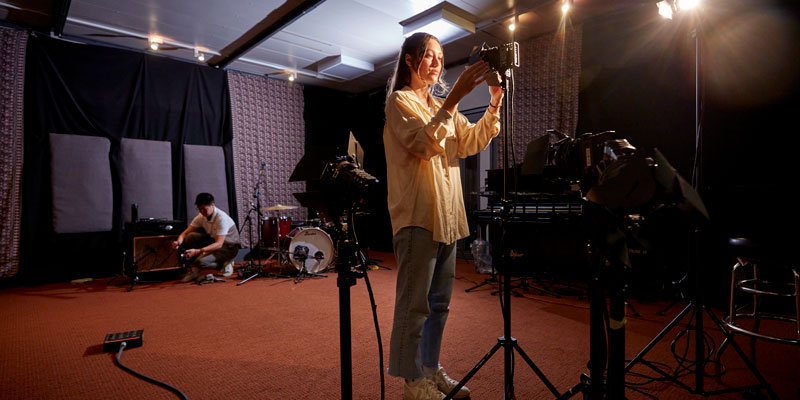
Caitria Demeroto, a Fordham College at Rose Hill junior who works on video and audio for WFUV, sets up a camera in Studio A.
Launching Pad for Success
Paul Cavalconte, FCRH ’83, a longtime radio host, got his start as a Fordham undergraduate at WFUV before his career took him to WQXR, WNEW, and Q104.3. He came back to WFUV as a guest host in 2013.
“I owe my radio career to 90.7 FM,” he said from the stage of the inauguration concert last fall. “And this is a very, very proud moment for us. We have a unique training program in sports and journalism—some of the most famous voices in media have come through Keating Hall and out into the airwaves of the world.”
That’s a credit to the hands-on training the students receive at WFUV, which Robin Shannon, the station’s news director, described as “vastly different than a lot of other organizations.” Over the past two decades, Shannon and former news director George Bodarky, FCRH ’93, who now serves as the community partnerships and training editor for WNYC, helped to grow and enhance the training program that Singleton established in the late 1980s. Today, “we have a reputation in the broadcast world of training students in a way that is going to benefit newsrooms all over the country,” Shannon said.
A big reason for that is the work of Bodarky, who was honored at WFUV’s On the Record event in November for his more than 20 years of service to the station. From 2001 until last year, he helped train many Fordham journalists.
“The thing about George is that dozens, maybe hundreds of people could be giving these remarks right now, telling you how George changed their life, how George opened the door to what became their career and their vocation,” said one of his former students, NPR White House correspondent Scott Detrow, FCRH ’07.
Shannon said the journalism program is about giving students ample opportunity to practice their skills in a professional environment. “It’s not just opening a book and reading about microphones or reading about interviews— it’s learning the equipment, going out, and covering stories that people are talking about.” She said students are also “allowed to make mistakes” and, with her guidance, they can “explore and experiment and kind of see what works for them.”
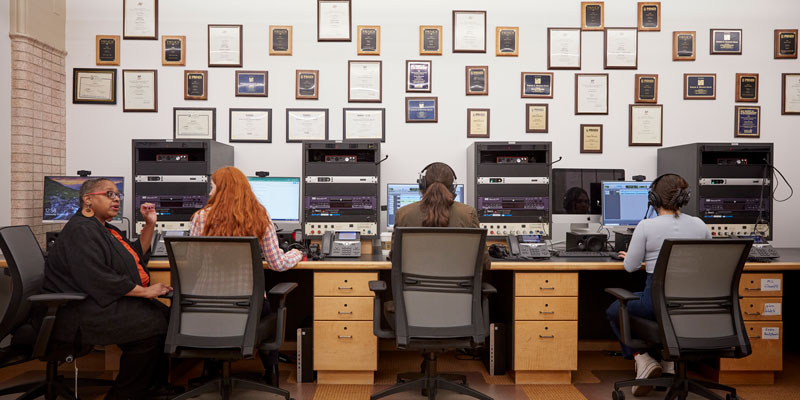
Students work in the WFUV newsroom with Robin Shannon, the station’s news director.
For Liam Dahlborn, a junior at Fordham College at Rose Hill, that opportunity to explore allowed him to develop his own role at the station—running the news department’s social media accounts. “That kind of position wasn’t really something that they were necessarily training for, but I was able to talk to Robin and talk to George, and be like, ‘This is something that I think we need to build on, the digital assets, now that we’re transitioning into a digital world,’” he said. “And they were really supportive of that.”
Dahlborn said that all the skills he’s acquiring at WFUV, which include writing a weekly subscriber newsletter, posting to Twitter, Facebook, and Instagram, and launching the station’s TikTok account, will help him pursue a career in media when he graduates from Fordham.
“Being able to have this professional environment in college is something that’s very unique,” he said. “Being able to work in a newsroom that’s professional, that’s state-of-the-art—that’s something that I think you don’t really get at other universities. And to be in New York City, pretty much everyone who I’ve talked to in New York City knows of WFUV.”
Noah Osborne, a senior at Fordham College at Rose Hill, said that his experience at WFUV opened doors for him, including his most recent internship at BronxNet television.
“That wouldn’t have been possible without WFUV,” he said. “Having WFUV anywhere on a resume seems to be the big talking point. I feel like a lot of my communication skills were honed here—especially as a reporter, as an anchor, even as a podcaster.”
Osborne said that until he worked at WFUV, he hadn’t thought much about podcasting and how it can be a great way to communicate with the audience. “I feel like it’s just made my delivery of certain lines of the news just so much more authentic, a lot more conversational, a lot more relaxed. It definitely did build my confidence as an aspiring media person.”
On the sports side, the WFUV legacy runs back to Vin Scully, the late, legendary voice of the Dodgers, who is considered the patron saint of Fordham-trained sportscasters, an ever-growing group that includes NBA Hall of Fame broadcaster Mike Breen, FCRH ’83; Michael Kay, FCRH ’82, the voice of the Yankees; Chris Carrino, GABELLI ’92, radio voice of the Brooklyn Nets; Tony Reali, FCRH ’00, host of ESPN’s Around the Horn; Bob Papa, GABELLI ’86, the radio voice of the New York Giants; and Ryan Ruocco, FCRH ’08, of the YES Network and ESPN.
When WFUV shifted from a student-run station to a professional staff overseeing the students in the late 1980s, Marty Glickman, the former New York Knicks, Jets, and Giants announcer, came on board as a coach, schooling the young sports journalists in the art of play-by-play and other types of broadcasts. He hired a producer named Bob Ahrens, who took the sports department to the next level, helping them gain press access to all 11 of the New York– area professional teams.
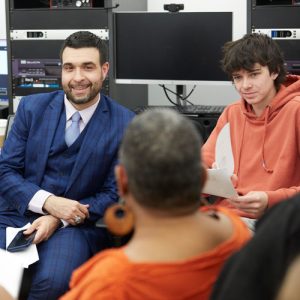
Bobby Ciafardini, the WFUV sports director, leads a staff meeting with Robin Shannon, the news director.
It’s that tradition that current sports director Bobby Ciafardini looks to build on. “I like to think that a big part of the legacy that I’m hoping to carve out here is that we have expanded the programming to include a lot more of the video component and the streaming part of what we are doing these days,” he said.
For example, One on One, New York’s longest-running sports call-in show, was founded in the 1970s, but now, in addition to catching it on the radio, viewers can tune in to a livestream and watch video clips on social media.
“The students are … learning more now than ever because they are multimedia sports professionals,” Ciafardini said. “When Sam [Davis] goes to a game now, he’s not just going to get audio; he’s doing a standup and interviewing players in both capacities.”
Davis, whose roles include social media coordinator, Mets beat reporter, and on-air broadcaster for Fordham sports, said that he wouldn’t have gotten the opportunities WFUV offered him anywhere else. “I think that covering the professional New York teams—as far as I know, I don’t think there’s really another college in the country that does that,” he said. “With the fact that everything is video now, we’re getting a lot of hands-on experience … not just being on air … but also video editing and pushing that out on social media, learning what works and what doesn’t.”
Both the news and sports departments have grown more diverse in recent years and provided more opportunities to students, something that is a strategic goal of the station, according to Singleton. For example, the sports department, which has traditionally been mostly male, now has an all-female sports podcast, All In.
Breen, who received the department’s Vin Scully Award for Excellence in Sports Broadcasting last year, said that he’s proud of the students who are a part of the station’s legacy. “Every Fordham student who decides to join this amazing radio station feels a responsibility, a responsibility to uphold the standards that all the previous students and student broadcasters have set,” he said, noting that he and his peers certainly felt it during the 1980s. “You’ve not only upheld the standards,” he said, “you’ve raised them. And I say bravo.”
Companionship for People
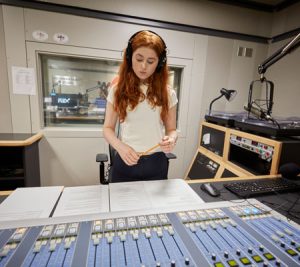
Maya Sargent, a fellow at WFUV and a graduate student in Fordham’s public media master’s program, gets ready to record a podcast.
Students who work at WFUV said that they were drawn to the station—and Fordham in general—not only for the chance to hone their technical skills but also to be part of its public media mission. That certainly was the case with Maya Sargent, which is why she applied to Fordham’s master’s degree program in the field. The program led her to a fellowship at WFUV, where she gets to tell the stories of a diverse group of New Yorkers.
“I’ve always kind of had that intrigue to learn more and find out more about communities, and New York feels like the epicenter of cultural engagement,” said Sargent, who came to Fordham from the U.K. “It’s such an eclectic mix, and I think that injects a lot of life into the media that we produce.”
That connection to local communities is something that Thao Matlock, co-chair of the WFUV Advisory Board, has found especially helpful during the COVID-19 pandemic. “It’s a companionship for people, and I think it’s what kept a lot of us sane during the pandemic, especially the first part when it was all doom and gloom,” she said. “A lot of us tuned in to WFUV because it was great music—we just kind of hung out; there was no anxiety. And then, the news part, the COVID news, was very calm, very sane.”
That’s been a hallmark of WFUV for decades—giving its listeners the news and music they need to find community and a reason to believe, especially in trying times. WFUV DJs received responses similar to Matlock’s from listeners in the early days of the COVID-19 pandemic. “I’m a nurse,” read one March 2020 message. “Today I listened in, [and] for the first time all month, danced in my kitchen, relaxed for the first time in ages. Grateful to WFUV for helping us stay safe, stay sane, stay connected in these uncertain times.” Another listener said the station’s DJs kept her company. “Now more than ever, many of us, myself included, are alone, and music means so much in our daily mindset.”
Breen, who went on to become a Hall of Fame basketball broadcaster, recalled his time as a late-night DJ for WFUV. He was on the air on December 8, 1980, the night John Lennon was killed. “The phones rang off the hook, and they were talking about what John Lennon meant to them,” he said. “One gentleman told me how he was about to commit suicide, but John Lennon’s song stopped him. Another told me he had a drinking problem, and John Lennon helped them through that. And it was the first time in my life I realized what music meant to people.”
Chuck Singleton, general manager of WFUV, said September 11, 2001, was another time when the power of music and the strength of the WFUV community were evident to the team at the station. “That day, as we reported on [the terrorist attacks], we were there for people. … I have a whole folder of letters and emails that people sent us that in their own, individual way, said, ‘I don’t know what I would have done without you.’”
Never Stopped Moving
Rich McLaughlin, who got his start at WFUV as an undergraduate just over two decades ago and is now the station’s program director, said putting all the pieces together—the commitment to music discovery, training young journalists, and providing a compelling public service to the community—is what makes WFUV “completely unique and dynamic.” “Not only do we take part in training that next generation of media professionals, but we really rely on our students to help push WFUV forward into the future,” he said. “And that’s one of my favorite things about working here because I find when it comes to social media, when it comes to music, when it comes to just general technology, our students, they know as much or more than some of us.”

Rich McLaughlin, FCRH ’01, GABELLI ’10, the station’s program director, chats with midday host Alisa Ali in between breaks.
One way to make sure the station remains unique and dynamic is to continue to diversify—both the musicians it plays on air and the staff it employs, Singleton said. For example, three years ago, Houston helped spearhead the station’s EQFM initiative to take on the issue of gender disparity in the music industry. It has a goal of 50{5b4d37f3b561c14bd186647c61229400cd4722d6fb37730c64ddff077a6b66c6} representation of women and gender minorities in music programming, events, and online features. Those efforts help the station continue to grow and reach new audiences, McLaughlin said. “Wherever there’s a platform that a WFUV listener is looking to listen to the station, or consume our content—wherever they are, we want to be.”
That spirit of innovation has run through the station since 1947, he said. “It’s really important that we maintain that heritage and the tradition that we have and take that with us as we move forward. I think you can do both—you can change and think about things differently from a content standpoint, from a technology standpoint, and still take into consideration the station’s history and legacy. I think that’s what the station has done all along.
“WFUV is celebrating 75 years—it’s never stopped changing. It’s never stopped moving. And that’s why it’s still as relevant as it is today.”
—Kelly Prinz, FCRH ’15, is an associate editor of this magazine. As a Fordham undergraduate, she was a WFUV sports reporter, host, and producer from 2012 to 2015.
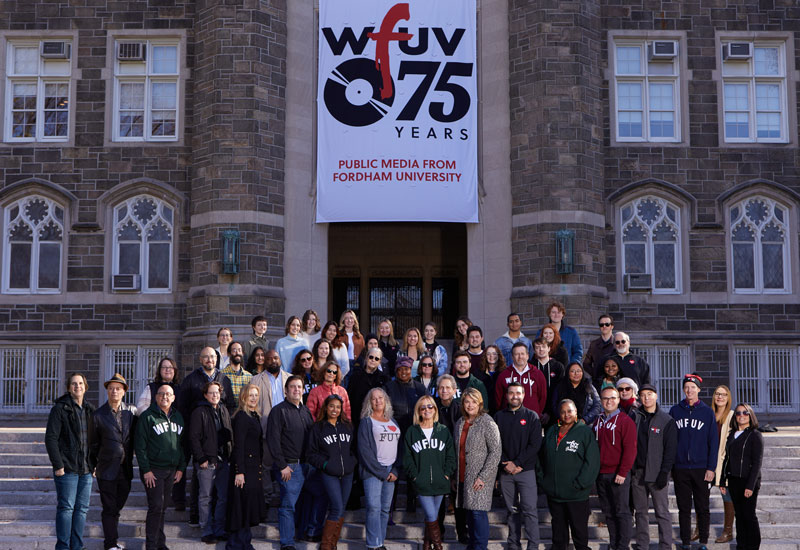
The WFUV Staff (Photo by Gus Philippas)

